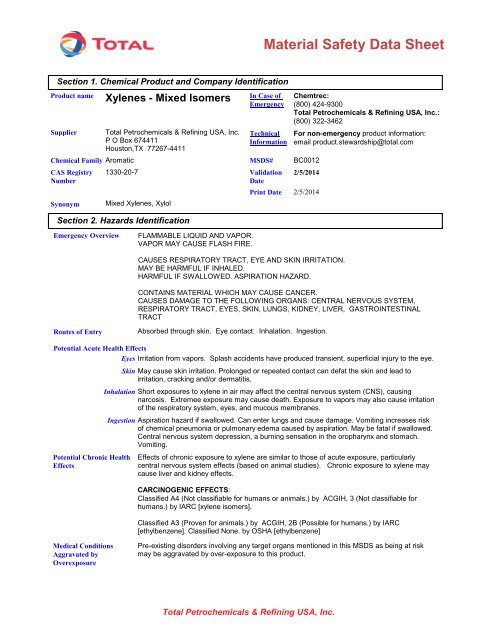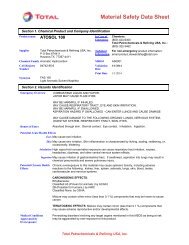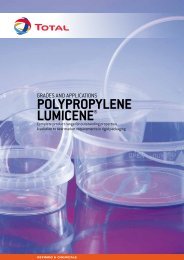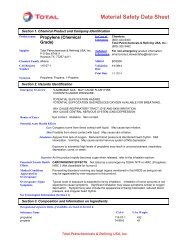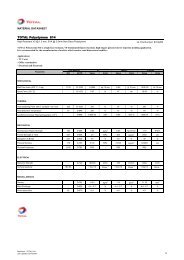6228 Xylene Isomers - Total Refining & Chemicals
6228 Xylene Isomers - Total Refining & Chemicals
6228 Xylene Isomers - Total Refining & Chemicals
You also want an ePaper? Increase the reach of your titles
YUMPU automatically turns print PDFs into web optimized ePapers that Google loves.
Material Safety Data Sheet<br />
Section 1. Chemical Product and Company Identification<br />
Product name<br />
Supplier<br />
Chemical Family Aromatic<br />
CAS Registry<br />
Number<br />
Synonym<br />
<strong>Xylene</strong>s - Mixed <strong>Isomers</strong><br />
<strong>Total</strong> Petrochemicals & <strong>Refining</strong> USA, Inc.<br />
P O Box 674411<br />
Houston,TX 77267-4411<br />
1330-20-7<br />
Mixed <strong>Xylene</strong>s, Xylol<br />
In Case of<br />
Emergency<br />
Technical<br />
Information<br />
MSDS#<br />
Validation<br />
Date<br />
Print Date<br />
Chemtrec:<br />
(800) 424-9300<br />
<strong>Total</strong> Petrochemicals & <strong>Refining</strong> USA, Inc.:<br />
(800) 322-3462<br />
For non-emergency product information:<br />
email product.stewardship@total.com<br />
BC0012<br />
2/5/2014<br />
2/5/2014<br />
Section 2. Hazards Identification<br />
Emergency Overview<br />
FLAMMABLE LIQUID AND VAPOR.<br />
VAPOR MAY CAUSE FLASH FIRE.<br />
CAUSES RESPIRATORY TRACT, EYE AND SKIN IRRITATION.<br />
MAY BE HARMFUL IF INHALED.<br />
HARMFUL IF SWALLOWED. ASPIRATION HAZARD.<br />
CONTAINS MATERIAL WHICH MAY CAUSE CANCER.<br />
CAUSES DAMAGE TO THE FOLLOWING ORGANS: CENTRAL NERVOUS SYSTEM,<br />
RESPIRATORY TRACT, EYES, SKIN, LUNGS, KIDNEY, LIVER, GASTROINTESTINAL<br />
TRACT<br />
Routes of Entry<br />
Absorbed through skin. Eye contact. Inhalation. Ingestion.<br />
Potential Acute Health Effects<br />
Eyes Irritation from vapors. Splash accidents have produced transient, superficial injury to the eye.<br />
Skin<br />
Inhalation<br />
Ingestion<br />
Potential Chronic Health<br />
Effects<br />
May cause skin irritation. Prolonged or repeated contact can defat the skin and lead to<br />
irritation, cracking and/or dermatitis.<br />
Short exposures to xylene in air may affect the central nervous system (CNS), causing<br />
narcosis. Extremee exposure may cause death. Exposure to vapors may also cause irritation<br />
of the respiratory system, eyes, and mucous membranes.<br />
Aspiration hazard if swallowed. Can enter lungs and cause damage. Vomiting increases risk<br />
of chemical pneumonia or pulmonary edema caused by aspiration. May be fatal if swallowed.<br />
Central nervous system depression, a burning sensation in the oropharynx and stomach.<br />
Vomiting.<br />
Effects of chronic exposure to xylene are similar to those of acute exposure, particularly<br />
central nervous system effects (based on animal studies). Chronic exposure to xylene may<br />
cause liver and kidney effects.<br />
CARCINOGENIC EFFECTS:<br />
Classified A4 (Not classifiable for humans or animals.) by ACGIH, 3 (Not classifiable for<br />
humans.) by IARC [xylene isomers].<br />
Classified A3 (Proven for animals.) by ACGIH, 2B (Possible for humans.) by IARC<br />
[ethylbenzene]. Classified None. by OSHA [ethylbenzene]<br />
Medical Conditions<br />
Aggravated by<br />
Overexposure<br />
Pre-existing disorders involving any target organs mentioned in this MSDS as being at risk<br />
may be aggravated by over-exposure to this product.<br />
<strong>Total</strong> Petrochemicals & <strong>Refining</strong> USA, Inc.
<strong>Xylene</strong>s - Mixed <strong>Isomers</strong> Page: 2/8<br />
Overexposure /Signs/<br />
Symptoms<br />
See Toxicological Information (Section 11)<br />
_<br />
Headache, tremors, apprehension, memory loss, weakness, dizziness, loss of appetite,<br />
nausea, ringing in the ears, irritability, thirst, anemia, mucosal bleeding, enlarged liver, and<br />
hyperplasia are reported when chronic inhalation of xylenes has occured. Repeated contact<br />
with the skin can cause defatting dermatitis. Reversible eye damage, including vacuoles in<br />
the cornea and conjuntiva, has occured with chronic xylene exposure.<br />
Section 3. Composition and Information on Ingredients<br />
Occupational exposure limits, if available, are listed in Section 8.<br />
Substance Name<br />
CAS #<br />
% by Weight<br />
xylene isomers 1330-20-7 >80<br />
ethylbenzene 100-41-4 < 20<br />
toluene 108-88-3
<strong>Xylene</strong>s - Mixed <strong>Isomers</strong> Page: 3/8<br />
Section 6. Accidental Release Measures<br />
_<br />
Small Spill and Leak<br />
Large Spill and Leak<br />
Absorb with an inert material and put the spilled material in an appropriate waste disposal.<br />
Eliminate ignition sources and ventilate area.<br />
Flammable liquid, insoluble in water. Contain spill and safely stop the flow. Warn personnel<br />
to move away. Eliminate all sources of ignition. Ventilate. Absorb with DRY earth, sand or<br />
other non-combustible material. Dike spill area and do not allow product to reach sewage<br />
system or surface or ground water. Notify any reportable spill to authorities.Do not allow any<br />
potentially contaminated water, including rain water, runoff from fire fighting or spills, to enter<br />
any waterway, sewer or drain.<br />
Section 7. Handling and Storage<br />
Handling<br />
Storage<br />
Put on appropriate personal protective equipment (see Section 8). Eating, drinking and<br />
smoking should be prohibited in areas where this material is handled, stored and processed.<br />
Workers should wash hands and face before eating, drinking and smoking. Do not get in<br />
eyes or on skin or clothing. Do not ingest. Avoid breathing vapor or mist. Use only with<br />
adequate ventilation. Wear appropriate respirator when ventilation is inadequate. Do not<br />
enter storage areas and confined spaces unless adequately ventilated. Keep in the original<br />
container or an approved alternative made from a compatible material, kept tightly closed<br />
when not in use. Store and use away from heat, sparks, open flame or any other ignition<br />
source. Use explosion-proof electrical (ventilating, lighting and material handling) equipment.<br />
Use non-sparking tools. Take precautionary measures against electrostatic discharges. To<br />
avoid fire or explosion, dissipate static electricity during transfer by grounding and bonding<br />
containers and equipment before transferring material. Empty containers retain product<br />
residue and can be hazardous. Do not reuse container.<br />
Keep container tightly closed. Keep in a cool, well-ventilated place.<br />
Take precautionary measures against electrostatic discharges.<br />
Flammable materials should be stored in a separate safety storage cabinet or room.<br />
All efforts should be made to prevent any leaks or spills. Storage tanks containing should be<br />
engineered to prevent contact with water resources, as this material could contaminate the<br />
water resources. Surface spills can reach groundwater through porous soil or cracked<br />
surfaces. The storage tanks should be monitored regularly for leaks. Where spills or leaks are<br />
possible, a comprehensive response plan should be developed and implemented.<br />
Section 8. Exposure Controls/Personal Protection<br />
Engineering Controls<br />
Use only with adequate ventilation. Use process enclosures, local exhaust ventilation or other<br />
engineering controls to keep worker exposure to airborne contaminants below any<br />
recommended or statutory limits. The engineering controls also need to keep gas, vapor or<br />
dust concentrations below any lower explosive limits. Use explosion-proof ventilation<br />
equipment.<br />
Personal Protection<br />
Protective Clothing<br />
(Pictograms)<br />
Eyes Safety glasses with side shields.<br />
Body Flame retardant clothing covering the entire body.<br />
Respiratory Be sure to use a MSHA/NIOSH approved respirator or equivalent at high concentrations.<br />
Hands Chemical resistant gloves if contact is possible.<br />
Feet Shoes.<br />
Personal Protection in<br />
Case of a Large Spill<br />
Product Name<br />
Splash goggles. Full suit. Vapor and dust respirator. Boots. Gloves. A self contained<br />
breathing apparatus should be used to avoid inhalation of the product. Suggested protective<br />
clothing might not be sufficient; consult a specialist BEFORE handling this product.<br />
Exposure Limits<br />
<strong>Total</strong> Petrochemicals & <strong>Refining</strong> USA, Inc.
<strong>Xylene</strong>s - Mixed <strong>Isomers</strong> Page: 4/8<br />
_<br />
xylene isomers ACGIH TLV (United States, 2012).<br />
TWA: 100 ppm 8 hour(s).<br />
STEL: 150 ppm 15 minute(s).<br />
OSHA PEL (United States, 11/2006).<br />
TWA: 100 ppm 8 hour(s).<br />
ethylbenzene ACGIH TLV (United States, 2012).<br />
TWA: 20 ppm 8 hour(s).<br />
OSHA PEL (United States, 11/2006).<br />
TWA: 100 ppm 8 hour(s).<br />
toluene OSHA PEL Z2 (United States, 11/2006).<br />
TWA: 200 ppm 8 hour(s).<br />
CEIL: 300 ppm<br />
AMP: 500 ppm 10 minute(s).<br />
ACGIH TLV (United States, 2012).<br />
TWA: 20 ppm 8 hour(s).<br />
Consult local authorities for acceptable exposure limits.<br />
Section 9. Physical and Chemical Properties<br />
Physical State and Appearance<br />
Color<br />
Odor<br />
Odor Threshold<br />
Molecular Weight<br />
Molecular Formula<br />
Boiling/Condensation Point<br />
Melting/Freezing Point<br />
Critical Temperature<br />
Specific Gravity<br />
Vapor Pressure<br />
Vapor Density<br />
Volatility<br />
Evaporation Rate<br />
VOC<br />
Solubility in Water<br />
Liquid.<br />
Clear Colorless.<br />
Sweet (aromatic) odor.<br />
0.7 to 40 ppm<br />
106<br />
C8H1O<br />
138.89°C (282°F)<br />
-47.4°C (-53.3°F)<br />
346°C (654.8°F)<br />
0.87 (Water = 1)<br />
8 mm of Hg (@ 25°C)<br />
The highest known value is 3.66 (Air = 1) (Ethylbenzene). Weighted average: 3.<br />
61 (Air = 1)<br />
100% (v/v).<br />
9.2 compared to Ether (anhydrous).<br />
100 (%)<br />
Negligible.<br />
Section 10. Stability and Reactivity<br />
Stability and Reactivity<br />
Conditions of Instability<br />
Incompatibility with<br />
Various Substances<br />
Hazardous<br />
Decomposition Products<br />
Hazardous<br />
Polymerization<br />
The product is stable.<br />
No additional remark.<br />
Extremely reactive or incompatible with acids.<br />
Reactive with oxidizing agents.<br />
Violent explosion may occur when chlorinating xylene with 1,3-dichloro-5,5-dimethyl-2,<br />
4-imidazolidindione (dichlorohydrantoin). The haloimide undergoes immediate self<br />
accelerating decomposition.<br />
Carbon oxides (CO, CO2) and soot.<br />
Will not occur.<br />
<strong>Total</strong> Petrochemicals & <strong>Refining</strong> USA, Inc.
<strong>Xylene</strong>s - Mixed <strong>Isomers</strong> Page: 5/8<br />
Section 11. Toxicological Information<br />
Toxicity to Animals<br />
Chronic Effects on<br />
Humans<br />
_<br />
Product/ingredient name Result Species Dose Exposure<br />
xylene isomers LD50 Dermal Rabbit >1700 mg/kg -<br />
LD50 Intraperitoneal Rat 2459 mg/kg -<br />
LD50 Oral Rat 4300 mg/kg -<br />
LD50 Subcutaneous Rat 1700 mg/kg -<br />
LC50 Inhalation Gas. Rat 5000 ppm 4 hours<br />
ethylbenzene LD50 Dermal Rabbit >5000 mg/kg -<br />
LD50 Dermal Rabbit 17800 uL/kg -<br />
LD50 Oral Rat 3500 mg/kg -<br />
LC50 Inhalation Vapor Rat 55000 mg/m3 2 hours<br />
Effects of chronic exposure to xylene are similar to those of acute exposure, particularly<br />
central nervous system effects (based on animal studies). Chronic exposure to xylene may<br />
cause liver and kidney effects.<br />
CARCINOGENIC EFFECTS:<br />
Classified A4 (Not classifiable for humans or animals.) by ACGIH, 3 (Not classifiable for<br />
humans.) by IARC [xylene isomers].<br />
Classified A3 (Proven for animals.) by ACGIH, 2B (Possible for humans.) by IARC<br />
[ethylbenzene]. Classified None. by OSHA [ethylbenzene].<br />
Classified None. by OSHA [toluene]. Classified A4 (Not classifiable for humans or animals.)<br />
by ACGIH, 3 (Not classifiable for humans.) by IARC [toluene].<br />
Other Toxic Effects on<br />
Humans<br />
From the animal and human toxicology data, xylenes can be characterized as neurotoxic<br />
chemicals at moderate to high doses inducing symptoms in humans of dizziness, headache,<br />
nausea, and neuromuscular effects, speech impairment, and amnesia at high doses.<br />
Aspiration into the lungs of even a small amount may cause severe injury, since its low<br />
viscosity and surface tension will cause it to spread over a large surface of pulmonary tissue.<br />
Special Remarks on<br />
Toxicity to Animals<br />
Results from acute oral, dermal or inhalation toxicity studies in rats and mice indicate that the<br />
acute toxicity of xylene isomers and mixed xylenes is very low. Acute toxicity was typically<br />
characterized by central nervous system depression. Animals exposed to xylene became<br />
uncoordinated, prostrate and comatose at doses that produced mortality within the dose<br />
group.<br />
Section 12. Ecological Information<br />
Ecotoxicity<br />
Biodegradable/OECD<br />
In repeated dose studies, the principle effects of xylenes were adaptive changes in the liver,<br />
body weight changes, organ weight changes and altered motor coordination.<br />
Ototoxicity (toxic effect on the structures of the ear, especially on its nerve supply) has been<br />
reported in animals but not in humans.<br />
<strong>Xylene</strong>s have not demonstrated genotoxic activity in animals or humans and do not appear to<br />
be immunotoxic.<br />
No adverse effects on reproductive performance were seen in laboratory studies and<br />
developmental toxicity (fetal weight decrements) occurred at doses that were typically also<br />
produced maternal toxic. Several developmental neurotoxicity studies have shown learning<br />
deficits in offspring of treated animals which resolved as offspring matured. No conclusive<br />
reproductive or developmental effects have been reported in human exposure studies.<br />
Product/ingredient name Result Species Exposure<br />
<strong>Xylene</strong> <strong>Isomers</strong> Acute EC50 1 mg/l Daphnia 48 hours<br />
Acute IC50 2.2 mg/l Algae 72 hours<br />
Acute LC50 2.6 mg/L Fish 96 hours<br />
Biodegrades in soil and ground water (aerobic and anaerobic denitrifying conditions).<br />
Mobility<br />
The product evaporates into the atmosphere. This material floats on water. Because of its<br />
high volatility, the product is unlikely to cause ground or water pollution.<br />
<strong>Total</strong> Petrochemicals & <strong>Refining</strong> USA, Inc.
<strong>Xylene</strong>s - Mixed <strong>Isomers</strong> Page: 6/8<br />
Section 13. Disposal Considerations<br />
Waste Information<br />
Waste Stream<br />
Consult your local or regional authorities.<br />
_<br />
Recover free liquid. Transfer to a safe disposal area in accordance with federal, state, and<br />
local regulations. Recycle to process, if possible.<br />
The classification of the product may meet the criteria for a hazardous waste.<br />
Section 14. Transport Information<br />
(for domestic bulk shipments, non-bulk shipments may differ)<br />
DOT Classification for<br />
Bulk Shipments (non bulk<br />
shipments may differ)<br />
Proper Shipping Name/<br />
Description<br />
UN Number<br />
Packing Group<br />
Marine Pollutant<br />
DOT CLASS 3: Flammable liquid.<br />
UN1993, Flammable Liquids n.o.s. (contains xylene isomers, ethylbenzene), 3, PG III RQ<br />
UN1993<br />
III<br />
Not listed in Appendix B to 49CFR172.101<br />
Hazardous Substances<br />
Reportable Quantity<br />
Special Provisions for<br />
Transport<br />
TDG Classification<br />
IMO/IMDG Classification<br />
ICAO/IATA Classification<br />
USCG Proper Shipping<br />
Name<br />
Transport in bulk<br />
according to Annex II of<br />
MARPOL 73/78 and the<br />
IBC Code<br />
<strong>Xylene</strong> isomers 100 lbs. (45.4 kg); ethylbenzene 1000 lbs (454kg).<br />
See codes as shown in 49 CFR 172.101 Column 7.<br />
TDG CLASS 3: Flammable liquid.<br />
TDG CLASS 9.2: Environmentally hazardous material.<br />
IMDG CLASS 3.1: Flammable liquid (Low flash point).<br />
IATA CLASS 3: Flammable liquid.<br />
<strong>Xylene</strong>s, Ethylbenzene mixture<br />
Product name: <strong>Xylene</strong>s/Ethylbenzene (10% or more) mixture (<strong>Xylene</strong> - Mixed <strong>Isomers</strong>)<br />
Pollution category: Y<br />
Ship type: 2G<br />
Section 15. Regulatory Information<br />
HCS Classification<br />
U.S. Federal Regulations<br />
Flammable liquid<br />
Carcinogen<br />
Target organ effects<br />
TSCA 8(a) PAIR: p-xylene<br />
TSCA 8(a) CDR Exempt/Partial exemption: Not determined<br />
United States inventory (TSCA 8b): All components are listed or exempted.<br />
SARA 302/304/311/312 extremely hazardous substances: To the best of our knowledge,<br />
there are no substances that would be at reportable levels for this regulation in this product.<br />
SARA 302/304 emergency planning and notification: ethylbenzene<br />
SARA 302/304/311/312 hazardous chemicals: <strong>Xylene</strong> <strong>Isomers</strong><br />
SARA 311/312 MSDS distribution - chemical inventory - hazard identification: <strong>Xylene</strong><br />
<strong>Isomers</strong>: Fire hazard, Immediate (acute) health hazard, Delayed (chronic) health hazard<br />
SARA 313 Supplier Notification<br />
This product contains the following EPCRA section 313 chemicals subject to the reporting<br />
requirements of section 313 of the Emergency Planning and Community Right-to-Know Act<br />
of 1986 (40 CFR 372 -Table 372.65).<br />
Product name CAS number Concentration (%)<br />
<strong>Xylene</strong> 1330-20-7 > 80<br />
ethylbenzene 100-41-4 < 20<br />
<strong>Total</strong> Petrochemicals & <strong>Refining</strong> USA, Inc.
<strong>Xylene</strong>s - Mixed <strong>Isomers</strong> Page: 7/8<br />
Clean Water Act (CWA) 307: ethylbenzene; toluene;<br />
Clean Water Act (CWA) 311: <strong>Xylene</strong><br />
International Regulations<br />
WHMIS (Canada) Class B-2: Flammable liquid<br />
_<br />
EINECS<br />
DSCL (EEC)<br />
CEPA Toxic substances: None of the components are listed.<br />
Canadian ARET: None of the components are listed.<br />
Canadian NPRI: The following components are listed: <strong>Xylene</strong><br />
Alberta Designated Substances: None of the components are listed.<br />
Ontario Designated Substances: None of the components are listed.<br />
Quebec Designated Substances: None of the components are listed.<br />
215-535-7<br />
R10- Flammable.<br />
R27- Very toxic in contact with skin.<br />
R41- Risk of serious damage to eyes.<br />
R37/38- Irritating to respiratory system and skin.<br />
CEPA DSL/NDSL<br />
International Lists<br />
State Regulations<br />
Section 16. Other Information<br />
Label requirements<br />
All components are listed or exempted.<br />
Australia inventory (AICS): All components are listed or exempted.<br />
China inventory (IECSC): All components are listed or exempted.<br />
Japan inventory (ENCS): All components are listed or exempted.<br />
Japan inventory (ISHL): Not determined.<br />
Korea inventory (KECI): All components are listed or exempted.<br />
New Zealand Inventory of <strong>Chemicals</strong> (NZIoC): All components are listed or exempted.<br />
Philippines inventory (PICCS): All components are listed or exempted.<br />
Florida substances: The following components are listed: <strong>Xylene</strong><br />
Massachusetts Substances: The following components are listed: <strong>Xylene</strong><br />
Michigan Critical Material: The following components are listed: <strong>Xylene</strong><br />
Minnesota Hazardous Substances: The following components are listed: <strong>Xylene</strong><br />
New Jersey Hazardous Substances: The following components are listed: <strong>Xylene</strong><br />
New York Acutely Hazardous Substances: The following components are listed: <strong>Xylene</strong><br />
(mixed); o-<strong>Xylene</strong>; p-<strong>Xylene</strong>; m-<strong>Xylene</strong>; Ethylbenzene<br />
Pennsylvania RTK Hazardous Substances: The following components are listed: <strong>Xylene</strong><br />
WARNING: This product contains a chemical or chemicals known to the State of California to<br />
cause cancer, birth defects or other reproductive harm.: ethylbenzene; toluene;<br />
FLAMMABLE LIQUID AND VAPOR.<br />
VAPOR MAY CAUSE FLASH FIRE.<br />
CAUSES RESPIRATORY TRACT, EYE AND SKIN IRRITATION.<br />
MAY BE HARMFUL IF INHALED.<br />
HARMFUL IF SWALLOWED. ASPIRATION HAZARD.<br />
Hazardous Material<br />
Information System<br />
(U.S.A.)<br />
CONTAINS MATERIAL WHICH MAY CAUSE CANCER.<br />
CAUSES DAMAGE TO THE FOLLOWING ORGANS: CENTRAL NERVOUS SYSTEM,<br />
RESPIRATORY TRACT, EYES, SKIN, LUNGS, KIDNEY, LIVER, GASTROINTESTINAL<br />
TRACT<br />
Health<br />
Fire Hazard<br />
Reactivity<br />
Personal Protection<br />
*<br />
2<br />
3<br />
0<br />
National Fire<br />
Protection<br />
Association<br />
(U.S.A.)<br />
Health<br />
2<br />
3<br />
0<br />
Fire Hazard<br />
Reactivity<br />
Specific Hazard<br />
<strong>Total</strong> Petrochemicals & <strong>Refining</strong> USA, Inc.
<strong>Xylene</strong>s - Mixed <strong>Isomers</strong> Page: 8/8<br />
References<br />
Chemtox Database<br />
HSDB - Hazardous Substances Data Bank<br />
_<br />
Validated on 2/5/2014.<br />
Printed 2/5/2014.<br />
Chemtrec:<br />
(800) 424-9300<br />
<strong>Total</strong> Petrochemicals & <strong>Refining</strong> USA, Inc.:<br />
(800) 322-3462<br />
Notice to Reader<br />
The information contained in this Material Safety Data Sheet (MSDS) / Safety Data Sheet (SDS) is believed by <strong>Total</strong> Petrochemicals & <strong>Refining</strong> USA, Inc.<br />
(TPRI) to be accurate on the date issued. However, materials may present unknown hazards and should be used with caution. Final determination of<br />
suitability and use of any material is the sole responsibility of the user. Neither TPRI nor any of its subsidiaries or affiliated companies assumes any liability<br />
whatsoever for the accuracy or completeness of the information contained herein or reliance thereto. If the material is repackaged, the user is responsible and<br />
must ensure that proper health, safety and other necessary information is included with the material and/or on the container. NO WARRANTIES OF ANY<br />
KIND, EITHER EXPRESSED OR IMPLIED, INCLUDING WARRANTIES OF MERCHANTABILITY OR FITNESS FOR A PARTICULAR PURPOSE,<br />
ARE MADE REGARDING THE MATERIALS OR THE INFORMATION CONTAINED IN THIS SDS. ALTERATION OF THIS DOCUMENT IS<br />
STRICTLY PROHIBITED.<br />
MSDS Name <strong>Xylene</strong> MSDS Code XYLENE<br />
25.01<br />
To obtain an electronic copy of this MSDS, please email: product.stewardship@total.com.<br />
<strong>Total</strong> Petrochemicals & <strong>Refining</strong> USA, Inc.


